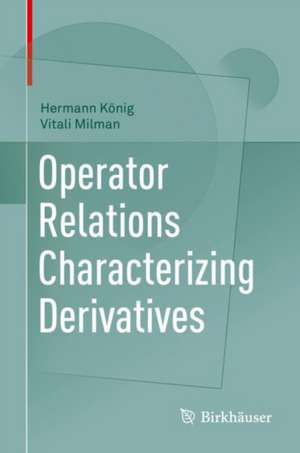Operator Relations Characterizing Derivatives
Autor Hermann König, Vitali Milmanen Limba Engleză Hardback – 11 oct 2018
The book does not require any specific knowledge of functional equations. All needed results are presented and proven and the book is addressed to a general mathematical audience.
| Toate formatele și edițiile | Preț | Express |
|---|---|---|
| Paperback (1) | 382.57 lei 6-8 săpt. | |
| Springer International Publishing – 9 dec 2019 | 382.57 lei 6-8 săpt. | |
| Hardback (1) | 389.88 lei 6-8 săpt. | |
| Springer International Publishing – 11 oct 2018 | 389.88 lei 6-8 săpt. |
Preț: 389.88 lei
Nou
Puncte Express: 585
Preț estimativ în valută:
74.61€ • 81.02$ • 62.67£
74.61€ • 81.02$ • 62.67£
Carte tipărită la comandă
Livrare economică 22 aprilie-06 mai
Preluare comenzi: 021 569.72.76
Specificații
ISBN-13: 9783030002404
ISBN-10: 3030002403
Pagini: 183
Ilustrații: VI, 191 p.
Dimensiuni: 155 x 235 mm
Greutate: 0.46 kg
Ediția:1st ed. 2018
Editura: Springer International Publishing
Colecția Birkhäuser
Locul publicării:Cham, Switzerland
ISBN-10: 3030002403
Pagini: 183
Ilustrații: VI, 191 p.
Dimensiuni: 155 x 235 mm
Greutate: 0.46 kg
Ediția:1st ed. 2018
Editura: Springer International Publishing
Colecția Birkhäuser
Locul publicării:Cham, Switzerland
Cuprins
Introduction.- Regular Solutions of Some Functional Equations.- The Leibniz Rule.- The Chain Rule.- Stability and Rigidity of the Leibniz and the Chain Rules.- The Chain Rule Inequality and its Perturbations.- The Second-Order Leibniz rule.- Non-localization Results.- The Second-Order Chain Rule.- Bibliography.- Subject Index.- Author Index.
Recenzii
“The reader will find an elegant treatment of the theory of such equations and their generalizations. … the Bibliography includes more then 50 titles.” (Edward L. Pekarev, zbMATH 1478.47001, 2022)
Textul de pe ultima copertă
This monograph develops an operator viewpoint for functional equations in classical function spaces of analysis, thus filling a void in the mathematical literature. Major constructions or operations in analysis are often characterized by some elementary properties, relations or equations which they satisfy. The authors present recent results on the problem to what extent the derivative is characterized by equations such as the Leibniz rule or the Chain rule operator equation in C^k-spaces. By localization, these operator equations turn into specific functional equations which the authors then solve. The second derivative, Sturm-Liouville operators and the Laplacian motivate the study of certain "second-order" operator equations. Additionally, the authors determine the general solution of these operator equations under weak assumptions of non-degeneration. In their approach, operators are not required to be linear, and the authors also try to avoid continuity conditions. The Leibniz rule, the Chain rule and its extensions turn out to be stable under perturbations and relaxations of assumptions on the form of the operators. The results yield an algebraic understanding of first- and second-order differential operators. Because the authors have chosen to characterize the derivative by algebraic relations, the rich operator-type structure behind the fundamental notion of the derivative and its relatives in analysis is discovered and explored.
The book does not require any specific knowledge of functional equations. All needed results are presented and proven and the book is addressed to a general mathematical audience.
Caracteristici
Develops an operator viewpoint for functional equations in classical function spaces of analysis
Demonstrates the rich, operator-type structure behind the fundamental notion of the derivative and its relatives in analysis
Fills a gap in mathematical literature; it explores algebraic properties of the derivative in a purely analytic setup
Gives a self-contained presentation; most proofs are written in detail
Demonstrates the rich, operator-type structure behind the fundamental notion of the derivative and its relatives in analysis
Fills a gap in mathematical literature; it explores algebraic properties of the derivative in a purely analytic setup
Gives a self-contained presentation; most proofs are written in detail
